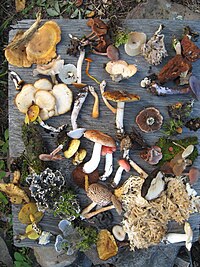
Photo from wikipedia
Grazing is the main way of utilizing understory vegetation in the tropics. However, the effects of grazing on vegetation diversity and soil functions in coconut plantations remain unclear. Therefore, this… Click to show full abstract
Grazing is the main way of utilizing understory vegetation in the tropics. However, the effects of grazing on vegetation diversity and soil functions in coconut plantations remain unclear. Therefore, this study was conducted in a young coconut plantation that was grazed by geese in Wenchang, China. We identified four grazing intensities according to the aboveground biomass, namely, no grazing (CK), light grazing (LG), moderate grazing (MG), and heavy grazing (HG). In April 2022, we used the quadrat method to investigate the composition and traits of vegetation, collected and analyzed 0–40-cm soil samples in each grazing intensity. The results showed that grazing changed the composition of understory species. The predominant species changed from Bidens pilosa to Praxelis clematidea + Paspalum thunbergii and then to P. clematidea with increasing grazing intensity. The richness, Shannon-Wiener index, evenness, modified functional attribute diversity (MFAD), functional divergence (Fdiv), and functional evenness (Feve) of CK were 4.5, 1.0, 0.29, 0.20, 0.84, and 0.80, respectively. Taxonomic diversity did not respond to LG, but responded significantly to MG and HG. Compared with CK, MG and HG increased richness by 96% and 200%, respectively, and Shannon-Wiener index increased by 40% and 98%, respectively. HG increased evenness by 95%. For functional diversity, MG and HG increased MFAD by 164% and 560%, respectively, but Fdiv and Feve did not respond to grazing intensity. The carbon (C) functioning, nitrogen (N) functioning, phosphorus (P) functioning, and multifunctionality in the 0–10-cm topsoil of CK were −0.03, 0.37, −0.06, 0.20, and 0.14, respectively. Grazing increased C functioning, P functioning, and multifunctionality in the 0–10-cm topsoil but decreased N functioning. Multiple linear regression showed that the taxonomic diversity and functional diversity could be used to estimate soil functions, but these vary among soil layers. In general, MG and HG can increase vegetation diversity and soil function. It may be possible to promote even distribution of geese by adding water sources or zoning grazing. Furthermore, quantitative grazing experiments are needed to determine the efficient use pattern of the understory in coconut plantations in tropics.
Journal Title: Frontiers in Plant Science
Year Published: 2023
Link to full text (if available)
Share on Social Media: Sign Up to like & get
recommendations!